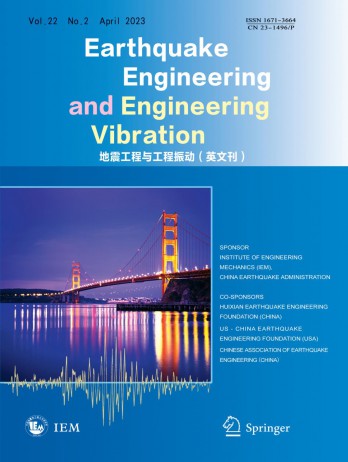发表咨询:400-888-9411 订阅咨询:400-888-1571

Earthquake Engineering and Engineering Vibration杂志简介
《Earthquake Engineering and Engineering Vibration》由中国地震局工程力学研究所主办、美国多学科地震工程研究所中心(MCEER)协办。
《Earthquake Engineering and Engineering Vibration》是反映我国地震工程与工程振动领域最新成果和国外该领域最新进展的学术性期刊,旨在促进国际学术交流,推动地震工程与工程振动学科的发展,减轻地震灾害。
《Earthquake Engineering and Engineering Vibration》主要刊登以下内容的综合评述、专题研究论文和科研简报:结构和工程体系震害评定,强震观测与分析,土木基础设施的地震危害性与危险性分析,场地对结构的影响和岩土工程,建筑物与生命线系统的抗震性能和设计原理,结构控制,现有基础设施系统的修复策略,结构动力学以及和地震工程相关的阻尼理论的进展,应急传感与监测系统和高性能材料在地震工程中的应用,以及风、波良和其它动荷载下土木工程结构振动问题。
Earthquake Engineering and Engineering Vibration发文方向
强震观测与分析、结构和工程体系震害评定、土木基础设施的地震危害性和危险性分析、场地效应和岩土地震工程
Earthquake Engineering and Engineering Vibration杂志特色
Title Page:
The title page should contain: Title, Authors, Affiliations,
Acknowledgement, and Footnotes supplying: Correspondent
author‘s information including: the full name, complete mailing address, telephone and fax number, and, if available, e-mail address; Job titles of all authors; and The name(s) of sponsor(s) of the research contained in the paper, along with grant number(s), if any.
General: The manuscript should be provided in single-spaced typing Time New Roman, 10.5 pt., on A4 size pages in electronic format using Microsoft Word. It must be written in English and should not exceed 13,000 word-equivalents. (A journal page contains approximately 1,300 words.) Technical notes should not exceed 4,000 word-equivalents. If it is necessary to include additional information, such as appendices, these should be submitted electronically for inclusion on a web site for the journal.
Abstracts: Each paper should include an Abstract of 150-200 words, reporting concisely on the purpose of the work, the scope of the effort, the procedures used to execute the work (if of special interest), the major findings, and a list of three to eight keywords. The abstract must be self-contained, and it must not require reference to the paper to be understood.
Text: Follow this order when typing manuscripts: Title, Abstract, Keywords, Main text, Appendix, References, Vitage, Figures (including captions) and then Tables. Footnotes are to be avoided (except for table footnotes). Please complete text minus the title page, acknowledgment, and any running headers with author names, to allow blinded review.
Units: The SI system is to be used throughout; if it is necessary to use other units, these should be added in parentheses.
References
References should appear within the text as the author name(s) followed by the year of publication in parentheses. A list of all references must be given at the end of the text in alphabetical order by last name of first author. Make sure the reference information is complete and accurate, including as necessary and in the following order: last names and initials of all authors; year of publication; title of paper, report or book chapter (in quotes); title of book or periodical (in italic); volume and issue numbers; name and location of publisher (for books), name and location of publisher or sponsor for proceedings), or city of publication (for non-U.S. journals); and inclusive page numbers. The references should be listed in the following style:
Liu Huixian and Zhang Zaiyong (1980), “Lessons Learned from the 1976 Tangshan Earthquake,” Proceedings of the 7th World Conference on Earthquake Engineering, Vol. IX, Istanbul, Turkey, pp.453– 460.
Huo Linsheng and Li Hongnan (2004), “Torsionally Coupled Response Control of Offshore Platform Structures Using Circular Tuned Liquid Column Dampers,” China Ocean Engineering, 18(2):173–183. (in Chinese)
Newmark NM and Rosenblueth E (1971), Fundamentals of Earthquake Engineering, Prentice-Hall, Inc., Englewood Cliffs, N.J.
杂志收录与荣誉
Earthquake Engineering and Engineering Vibration杂志数据统计注:由于版面限制,此处仅列出部分数据信息,了解详情请联系客服 了解详情 >>
年度期刊评价报告 (本刊综合数据对比及走势)
名词解释:
影响因子:指该期刊近两年文献的平均被引用率,即该期刊前两年论文在评价当年每篇论文被引用的平均次数
被引半衰期:衡量期刊老化速度快慢的一种指标,指某一期刊论文在某年被引用的全部次数中,较新的一半被引论文刊载的时间跨度
期刊他引率:他引率是指,此期刊被引用次数中,被其他刊引用次数所占的比例
引用半衰期:指某种期刊在某年中所引用的全部参考文献中较新的一半是在最近多少年时段内刊载的
平均引文率:在给定的时间内,期刊篇均参考文献量,用以测度期刊的平均引文水平,考察期刊吸收信息的能力以及科学交流程度的高低
杂志被引半衰期、引用半衰期
杂志影响因子、被引次数
杂志发文量、期刊他引率
杂志平均引文率
我们提供的服务
在线客服
一对一咨询服务、简单快捷、省时省力
了解更多 >快递配送
直邮到家、实时跟踪、更安全更省心
了解更多 >杂志订阅
去除中间环节享受低价,物流进度实时通知
了解更多 >杂志推荐
正版杂志,匹配度高、性价比高、成功率高
了解更多 >期刊导航
常见问题
免责声明
若用户需要出版服务,请联系出版商,地址:哈尔滨学府路9号,邮编:150080。